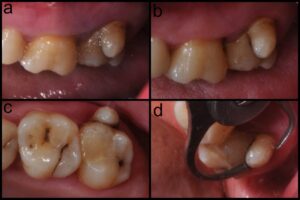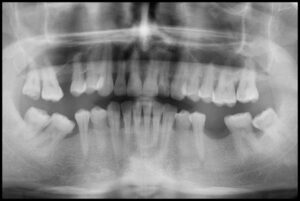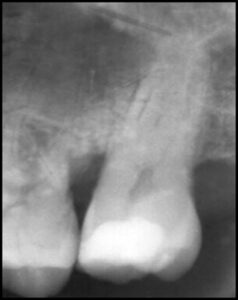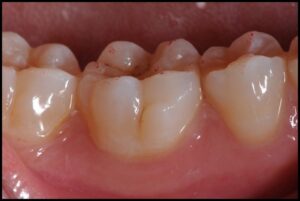Merve Haberal1*, Yusuf Bayraktar2
1Specialist Dentist, Department of Restorative Dentistry, Faculty of Dentistry, Kırıkkale University, Kırıkkale, Turkey
2Associate Professor Dr., Department of Restorative Dentistry, Faculty of Dentistry, Kırıkkale University, Kırıkkale, Turkey
*Correspondence author: Merve Haberal, Specialist Dentist, Department of Restorative Dentistry, Faculty of Dentistry, Kırıkkale University, Kırıkkale, Turkey; E-mail: [email protected]
Published Date: 29-12-2024
Copyright© 2024 by Haberal M, et al. All rights reserved. This is an open access article distributed under the terms of the Creative Commons Attribution License, which permits unrestricted use, distribution, and reproduction in any medium, provided the original author and source are credited.
Abstract
Human teeth can show variations that can be found as anomalies on the crown, root and both. The paramolar tubercle (Bolk cusp) is a developmental accessory tubercle that can be seen rarely on the buccal surfaces of molars and premolars. The aim of this article is to inform dental practitioners about the paramolar tubercles and describe the anomaly in two cases. In the first case, the paramolar tubercle have seen on the buccal surface of the left maxillary second molar and in the second case on the buccal surface of the right mandibular first molar. As a result, teeth with this anomaly may require follow-up or special procedures if treatment is necessary. Therefore, clinicians should have sufficient knowledge about this anomaly.
Keywords: Bolk Cusp; Dental Anomaly; Extra Cusp; Maxilllary Molar; Mandibular Molar; Paramolar Tubercle
Introduction
Additional tubercles are clinically occasional variations to the tooth surface. An additional tubercle formation occurring on the buccal surfaces of the maxillary and mandibular permanent molars in humans was first described in the literature by Bolk in 1916 and named ‘paramolar tubercle’ [1]. In 1945, Dahlberg defined the presence of the paramolar tubercle on maxillary molars as ‘parastyle’ and on mandibular molars as ‘protostylid’, according to paleontological nomenclature [2]. These tubercles may be enamel and dentin structures with or without a pulp chamber or sometimes they may be cause only by enamel overgrowth. Bolk reported that maxillary molars with paramolar tubercles tend to merge at the root, but mandibular molars tend to have their own roots even in the absence of tubercles [1]. If paramolar tubercles are large, sharp and prominently protruding, they may irritate the buccal mucosa or impair aesthetics. Associated grooves may predispose to plaque accumulation and early carious lesions. Early tooth contact caused by the paramolar tubercle can cause occlusal interference and habitual jaw displacement. If the paramolar tubercle is small and easy to maintain, no treatment is necessary. If grooves are present, prophylactic closure can be performed to prevent caries formation [3]. According to the literature, the molars with the highest incidence of paramolar tubercles are the maxillary second molars [4-6].
Various clinical presentations of paramolar tubercles in permanent teeth are described in Table 1 [7]. This report presents a case of paramolar tubercles, one in the left maxillary second molar and the other in the right mandibular first molar. Informed consent forms have been approved for both patients.
Grade | Description |
I | Tubercles 2 and 3 have smooth buccal surfaces. |
II | Between tubercles 2 and 3, there is a pit in or near the buccal groove. |
III | Tubercle 2 usually has a small tubercle with an attached tip. |
IV | A medium tubercle with a free apex can be seen anywhere on the buccal surface. |
V | A large tubercle with a free apex can be found anywhere on the buccal surface. |
VI | A very large tubercle with a free apex can be found anywhere on the buccal surface. |
VII | There is a free peg-shaped crown attached to the third molar root. |
Table 1: Varied clinical presentation of paramolar tubercle in permanent molars.
Case Report
Case 1
The 27-year-old man applied to cure the rotations in the patients’ teeth at the Kırıkkale University Faculty of Dentistry Department of Restorative Dentistry. No systemic disease of the patient has been detected in the received anamnesis. In the intraoral examination, a well-formed tubercle was observed on the mesiobuccal cusp of the left maxillary second molar, as shown in Fig. 1. Fig. 2 shows the image of the teeth on the panoramic radiograph and Fig. 3 shows the image of the teeth on the periapical radiograph. This tubercle was not sharp and did not cause any irritation to the surrounding soft tissue. Plaque accumulation has been observed on the tubercle, but no caries has been found around the tubercle. Besides, no soft tissue has been observed. The aproximal caries lesion, independent of the paramaolar tubercle, has been treated with composite restoration. The patient has also adviced instructed to brush the tooth surface carefully.
Case 2
The 18-year-old woman applied to cure the rotations in the patients’ teeth at the Kırıkkale University Faculty of Dentistry Department of Restorative Dentistry. No systemic disease of the patient has been detected in the received anamnesis. In the intraoral examination, a well-formed tubercle was observed on the mesiobuccal cusp of the right mandibular first molar, as shown in Fig. 4. This tubercle was not sharp and did not cause any irritation to the surrounding soft tissue. No plaque accumulation has been observed on the tubercle. The patient has been advised to continue regular oral care.

Figure 1: Extra tubercle on the mesiobuccal aspect of the left maxillary second molar.

Figure 2: Panoramic radiography of the teeth.

Figure 3: Periapikal radiography of the teeth.

Figure 4: Extra tubercle on the mesiobuccal aspect of the right mandibular first molar.
Discussion
Variations in the coronal and radicular morphology of the relevant tooth are present in the paramolar tubercul, a rather unusual developing accessory process on the buccal surface of molars and premolars. Paramolar tubercle is a rather rare condition. Typically, they manifest in the permanent dentition unilaterally. In the study by Kazak, et al., investigating paramolar tubercles in the Turkish population using CBCT, only one case of bilateral paramolar tubercles was observed [8]. In comparison to maxillary second molars (%0,4 ila %2,8) or maxillary third molars (%0 ila %4,7) in all the populations examined, the prevalence of this structure is significantly lower in maxillary first molars (%0 ila %0,1) [9]. On the other hand, in some studies conducted in the Turkish population, no paramolar tubercle was observed in maxillary first molars, but paramolar tubercle was observed in mandibular first molars [10]. Many authors have documented paramolar tubercles in first molars, although Bolk concluded that the anomaly never occurs in first permanent molars [11-13]. In this case report, the second molar tooth with the highest number of paramolar tubercles and the first molar tooth with the lowest number of paramolar tubercles were reported.
Paramolar tubercles can be explained as nonmetric dental traits in which racial and ethnic origin play an important role in their formation. These structures can be considered as normal morphological features of dentition [9]. The prevalence of paramolar tubercles is high among Native Americans in the Southwest and low among Africans, Europeans and their descendants in the Americas [2]. The worldwide average prevalence of paramolar tubercles is %1.58, while in Turkey it is %2.76 [8,14].
To understand the origin of paramolar tubercles, one must examine the events that occurred during the creation of the dental tubercles. Enamel knots, which are the first indications of tubercle patterns that differentiate species, are epithelial signaling centers that grow at future tubercle sites in developing teeth. Mesenchymal and enamel knot signals work together to control tubercle patterning and, in turn, the form of the tooth crown. ActivinβA and Bone Morphogenetic Proteins (BMP) can trigger the differentiation of knot cells by promoting the production of p21, a cyclin-dependent kinase inhibitor that is one of the initial differentiation markers for knot cells. In vivo, its inductive potential may be controlled by inhibitors such as follistatin, ectodin and BMP-3. It has been suggested that BMP-4 controls the time and pace of differentiation, which in turn influences tubercle patterning. On the other hand, tubercle ActivinβA’s promotion of cell proliferation and subsequent generation of spontaneous tubercles might possibly account for the excess tubercles. Currently, tubercle patterning appears to be a dynamic process controlled by the tooth’s whole developmental history [15].
The paramolar tubercles are clinically significant because they affect treatment techniques and related difficulties in several dental professions. Endodontic treatment is complicated by the presence of a tubercle and an extra root canal. When pulp is found in a paramolar tubercle, the link between the tubercle’s pulp and the pulp of the tooth must be discovered. When the tubercle canal connects to the major canals, both should be treated at the same time [16]. Two-dimensional imaging techniques have limitations for examining teeth with paramolar tubercles because the tubercles are superimposed on the regular architecture of the tooth. As a result, these techniques are unable to distinguish the internal anatomy of the tubercle. Periapical radiography, which shows two-dimensional (2D) images of three-dimensional (3D) structures, shows the presence of these tubercles but does not provide information about the exact morphology and anatomy of these structures. It is not sufficient for endodontic treatment because it cannot clearly show whether there is a relationship between the pulp of the tubercle and the pulp of the tooth involved. In cases where the attachment level of the paramolar tubercle, pulp chamber or root structure is also present, the pulp canal cannot be recognized. For a healthy treatment, it should be investigated whether a separate canal is present throughout or whether it merges with the main canal [9]. For this reason, Cone Beam Computed Tomography (CBCT) examination of teeth containing paramolar tubercles will be useful to examine their morphological features in more detail [3]. Ohishi, et al., used CBCT to evaluate the root architecture of three instances of paramolar tubercles in the maxillary second molar [3]. In all three cases, the root of the paramolar tubercle was joined to the root of the distobuccal tubercle. Each had its own pulp chamber and canals connected to the distobuccal canal at various levels. The canals were nearly round to depressed circular in shape, similar to the outline form of the roots. In this case report, the teeth were analyzed visually and with two-dimensional radiographs.
Jain, et al., used CBCT to examine the root canal morphology of two lobulated paramolar tubercles attached to the buccal surface of the left maxillary second molar [17]. They found that the mesiobuccal and distobuccal root canals of the tooth fused with the root canals of the paramolar tubercles. A C-shaped root canal design, root fusion and a paramolar tubercle with an extra canal related to or separate from the tooth’s major root canals were mentioned in the research by Çolakoğlu, et al., as factors that might influence the treatment plan [10]. Because of this, it is advised that CBCT be used to check teeth with paramolar tubercles, particularly maxillary second molars, prior to any dental work.
Although the tubercle in mandibular molars is modest, a paramolar root and an extra canal may be present, according to Bolk. Furthermore, mandibular paramolar tubercles have separate roots, whereas maxillary paramolar tubercles join at the base [1]. The growth of tubercles can vary in size and if they are particularly large, they may be connected to the formation of a separate root [12]. In our case report, the width of the paramolar tubercle in case 1 was 4.4 mm and the length was 6.1 mm; in case 2, the width and length of the paramolar tubercle were approximately 2 mm.
The paramolar tubercles are located on the buccal side of the affected tooth and usually do not come into contact with the antagonist tooth during occlusion. Therefore, they are of little functional importance. The teeth’s unusual form is caused by the genes Pax and Msx [18]. On the other hand, the paramolar tubercles are susceptible to plaque accumulation, which raises the risk of periodontal disease and dental caries (gingivitis or localized periodontitis). If the paramolar tubercle is in a structure that facilitates plaque accumulation, patients should be informed about this and they should be told to brush that area more carefully. If plaque removal is not possible with tooth brushing, the relevant area can be made more cleanable with a minimally invasive restoration. Additional clinical consequences include the sharp and prominent tubercle irritating the buccal mucosa, challenges banding teeth orthodontically, early tooth contact resulting in occlusal interference and habitual jaw repositioning, issues with crown restoration preparation and challenges receiving endodontic therapy [15,19]. Paramolar tubercles frequently need to be removed via ameloplasty because they prevent bracket cementation and orthodontic archwire alignment during treatment [20]. Paramolar tubercles are also used in forensic identification [21,22]. In this case report, paramolar tubercles in the left maxillary second molar and the right mandibular first molar are discussed. In both cases, caries and periodontal problems related to paramolar tubercles were not observed. Paramolar tubercles do not show sharp edge characteristics. The patient did not receive any treatment for these teeth except for oral hygiene advice.
Conclusion
In conclusion, the cases in this case report involve an asymptomatic dental anomaly that does not cause any variation in the tooth or arch. Clinicians should have extensive knowledge about developmental anomalies, their variations and their clinical consequences. Early diagnosis of paramolar tubercles helps to avoid complications in the future when the tooth requires treatment.
Conflict of Interest
There are no potential conflicts of interest to declare in this systematic review.
Author Contributions
All authors contributed equally for this paper.
References
- Bolk L. Problems of human dentition. Am J Anat. 1916;19(1):91-148.
- Dahlberg AA. The paramolar tubercle (Bolk). Am J Phys Anthropol. 1945;3(1):97-103.
- Ohishi K, Ohishi M, Takahashi A, Kido J-i, Uemura S, Nagata T. Examination of the roots of paramolar tuberoles with computed tomography: report of 3 cases. Oral Surg Oral Med Oral Pathol Oral Radiol Endod. 1999;88(4):479-83.
- Nayak G, Shetty S, Singh I. Paramolar tubercle: A diversity in canal configuration identified with the aid of spiral computed tomography. Eur J Dent. 2013;7(1):139.
- Scriven G, Roger J, Brook A, Scott GR, Mihailidis S, Khamis MFB, et al. Frequency of occurrence and degree of expression of the parastyle in several modern human populations: frequency of parastyle. Dent Anthropol J. 2018;31(1):3-9.
- Lopamudra D, Shekar KS, Chandra R, Moinuddin MMK, Prasad K, Priya S. Endodontic management by cone beam computed tomography and vista scan of maxillary second molar with parastyle-a case report. Webmed Central Dent. 2016;7(6):WMC005134.
- Turner CG, Nichol CR, Scott GR. Scoring procedures for key morphological traits of the permanent dentition: the arizona state university dental anthropology system. Adv Dent Anthropol. 1991;13-31.
- Kazak M, Çolakoğlu G, Elcin MA, Somtürk E, Günal Ş. Examination of paramolar tubercles in turkish population using cone beam computed tomography. Int J Morphol. 2017; 35:1416-21.
- Desai VD, Gaurav I, Das S, Kumar MS. Paramolar complex-The microdental variations: Case series with review of literature. Ann Bioanthropology. 2014;2(2):65.
- Colakoglu G, Kaya Buyukbayram I, Elcin M, Kazak M, Sezer H. Evaluation of the internal anatomy of paramolar tubercles using cone-beam computed tomography. Surg Radiol Anat. 2020;42:15-21.
- Narsapur SA, Choudhari S. Bilateral protostylids and parastyles associated with hypodontia of maxillary lateral incisor: Report of two rare clinical cases. J Indian Acad Oral Med Radiol. 2017;29(1):78-81.
- Kustaloglu OA. Paramolar structures of the upper dentition. J Dent Res. 1962;41(1):75-83.
- Ghafoor S. Unilateral protostylid on buccal surface of permanent maxillary first molar: a rare finding. JPDA. 2018;27(03):157.
- Scott GR, Turner CG. Anthropology of modern human teeth: Cambridge University Press Cambridge; 1997.
- Sharma S, Tyagi S, Kumar V. Paramolar tubercle-Bolk cusp: a case report. J Oral Res Rev. 2018;10(2):76.
- Ballal S, Sachdeva GS, Kandaswamy D. Endodontic management of a fused mandibular second molar and paramolar with the aid of spiral computed tomography: a case report. J Endod. 2007;33(10):1247-51.
- Jain P, Ananthnarayan K, Ballal S, Natanasabapathy V. Endodontic management of maxillary second molars fused with paramolar tubercles diagnosed by cone beam computed tomography-two case reports. J Dent (Tehran). 2014;11(6):726.
- Turner RA, Harris EF. Maxillary second premolars with paramolar tubercles. Dent Anthropol J. 2004;17(3):75-8.
- Mull JP, Manjunath M. Paramolar tubercle in endodontics: An overview, case report and specimen study. J Pierre Fauchard Acad. (India Sect.). 2013;27(4):124-8.
- Kallay J. Extra cusp formation in the human dentition. J Dent Res. 1966;45(5):1381-94.
- Appadurai R, Lingeshwar D, Missier MS, Maila SV. Permanent mandibular protostylid: a rare developmental anomaly and its overview. Indian J Dent Res. 2018;29(2):244-6.
- Lakshman AR, Kannepady SK, Kalkur C. Parastyle: Report of two rare cases. Front Clin Med. 2014;1:1-4.
Article Type
Case Report
Publication History
Received Date: 01-12-2024
Accepted Date: 22-12-2024
Published Date: 29-12-2024
Copyright© 2024 by Haberal M, et al. All rights reserved. This is an open access article distributed under the terms of the Creative Commons Attribution License, which permits unrestricted use, distribution, and reproduction in any medium, provided the original author and source are credited.
Citation: Haberal M, et al. Paramolar Tubercles (Bolk Cusps): Two Case Reports. J Dental Health Oral Res. 2024;5(3):1-6.

Figure 1: Extra tubercle on the mesiobuccal aspect of the left maxillary second molar.

Figure 2: Panoramic radiography of the teeth.

Figure 3: Periapikal radiography of the teeth.

Figure 4: Extra tubercle on the mesiobuccal aspect of the right mandibular first molar.
Grade | Description |
I | Tubercles 2 and 3 have smooth buccal surfaces. |
II | Between tubercles 2 and 3, there is a pit in or near the buccal groove. |
III | Tubercle 2 usually has a small tubercle with an attached tip. |
IV | A medium tubercle with a free apex can be seen anywhere on the buccal surface. |
V | A large tubercle with a free apex can be found anywhere on the buccal surface. |
VI | A very large tubercle with a free apex can be found anywhere on the buccal surface. |
VII | There is a free peg-shaped crown attached to the third molar root. |
Table 1: Varied clinical presentation of paramolar tubercle in permanent molar


